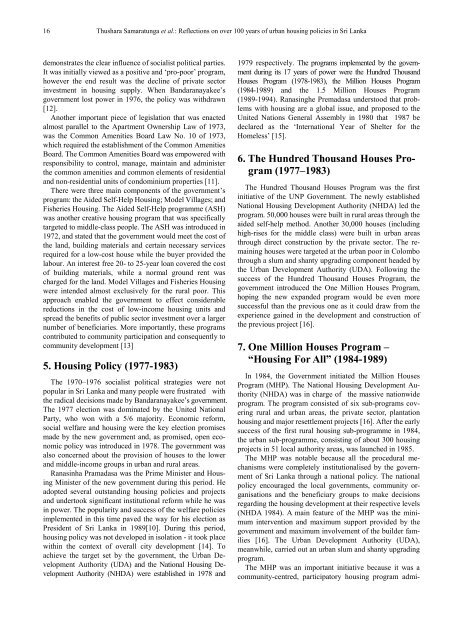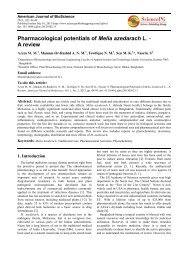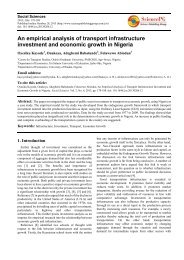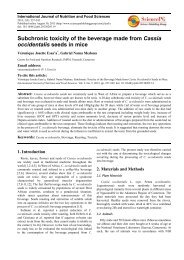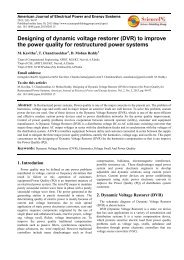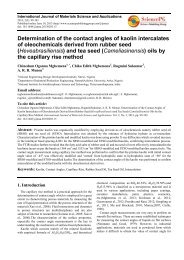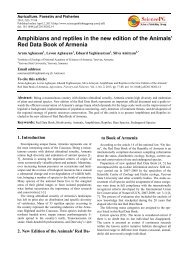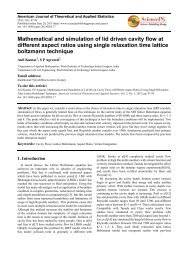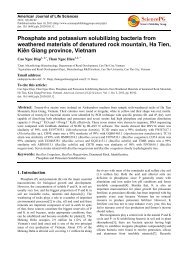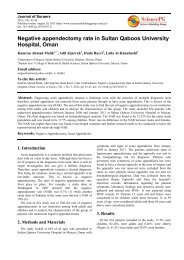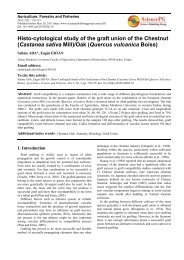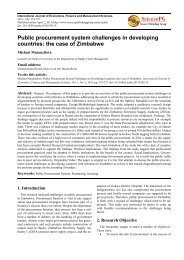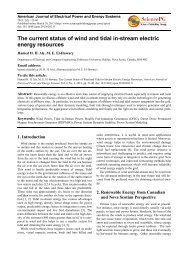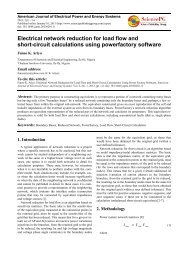Reflections on over 100 years of urban housing policies in Sri Lanka
Reflections on over 100 years of urban housing policies in Sri Lanka
Reflections on over 100 years of urban housing policies in Sri Lanka
You also want an ePaper? Increase the reach of your titles
YUMPU automatically turns print PDFs into web optimized ePapers that Google loves.
16 Thushara Samaratunga et al.: <str<strong>on</strong>g>Reflecti<strong>on</strong>s</str<strong>on</strong>g> <strong>on</strong> <strong>over</strong> <strong>100</strong> <strong>years</strong> <strong>of</strong> <strong>urban</strong> <strong>hous<strong>in</strong>g</strong> <strong>policies</strong> <strong>in</strong> <strong>Sri</strong> <strong>Lanka</strong>dem<strong>on</strong>strates the clear <strong>in</strong>fluence <strong>of</strong> socialist political parties.It was <strong>in</strong>itially viewed as a positive and ‘pro-poor’ program,however the end result was the decl<strong>in</strong>e <strong>of</strong> private sector<strong>in</strong>vestment <strong>in</strong> <strong>hous<strong>in</strong>g</strong> supply. When Bandaranayakee’sg<strong>over</strong>nment lost power <strong>in</strong> 1976, the policy was withdrawn[12].Another important piece <strong>of</strong> legislati<strong>on</strong> that was enactedalmost parallel to the Apartment Ownership Law <strong>of</strong> 1973,was the Comm<strong>on</strong> Amenities Board Law No. 10 <strong>of</strong> 1973,which required the establishment <strong>of</strong> the Comm<strong>on</strong> AmenitiesBoard. The Comm<strong>on</strong> Amenities Board was empowered withresp<strong>on</strong>sibility to c<strong>on</strong>trol, manage, ma<strong>in</strong>ta<strong>in</strong> and adm<strong>in</strong>isterthe comm<strong>on</strong> amenities and comm<strong>on</strong> elements <strong>of</strong> residentialand n<strong>on</strong>-residential units <strong>of</strong> c<strong>on</strong>dom<strong>in</strong>ium properties [11].There were three ma<strong>in</strong> comp<strong>on</strong>ents <strong>of</strong> the g<strong>over</strong>nment’sprogram: the Aided Self-Help Hous<strong>in</strong>g; Model Villages; andFisheries Hous<strong>in</strong>g. The Aided Self-Help programme (ASH)was another creative <strong>hous<strong>in</strong>g</strong> program that was specificallytargeted to middle-class people. The ASH was <strong>in</strong>troduced <strong>in</strong>1972, and stated that the g<strong>over</strong>nment would meet the cost <strong>of</strong>the land, build<strong>in</strong>g materials and certa<strong>in</strong> necessary servicesrequired for a low-cost house while the buyer provided thelabour. An <strong>in</strong>terest free 20- to 25-year loan c<strong>over</strong>ed the cost<strong>of</strong> build<strong>in</strong>g materials, while a normal ground rent wascharged for the land. Model Villages and Fisheries Hous<strong>in</strong>gwere <strong>in</strong>tended almost exclusively for the rural poor. Thisapproach enabled the g<strong>over</strong>nment to effect c<strong>on</strong>siderablereducti<strong>on</strong>s <strong>in</strong> the cost <strong>of</strong> low-<strong>in</strong>come <strong>hous<strong>in</strong>g</strong> units andspread the benefits <strong>of</strong> public sector <strong>in</strong>vestment <strong>over</strong> a largernumber <strong>of</strong> beneficiaries. More importantly, these programsc<strong>on</strong>tributed to community participati<strong>on</strong> and c<strong>on</strong>sequently tocommunity development [13]5. Hous<strong>in</strong>g Policy (1977-1983)The 1970–1976 socialist political strategies were notpopular <strong>in</strong> <strong>Sri</strong> <strong>Lanka</strong> and many people were frustrated withthe radical decisi<strong>on</strong>s made by Bandaranayakee’s g<strong>over</strong>nment.The 1977 electi<strong>on</strong> was dom<strong>in</strong>ated by the United Nati<strong>on</strong>alParty, who w<strong>on</strong> with a 5/6 majority. Ec<strong>on</strong>omic reform,social welfare and <strong>hous<strong>in</strong>g</strong> were the key electi<strong>on</strong> promisesmade by the new g<strong>over</strong>nment and, as promised, open ec<strong>on</strong>omicpolicy was <strong>in</strong>troduced <strong>in</strong> 1978. The g<strong>over</strong>nment wasalso c<strong>on</strong>cerned about the provisi<strong>on</strong> <strong>of</strong> houses to the lowerand middle-<strong>in</strong>come groups <strong>in</strong> <strong>urban</strong> and rural areas.Ranas<strong>in</strong>ha Pramadasa was the Prime M<strong>in</strong>ister and Hous<strong>in</strong>gM<strong>in</strong>ister <strong>of</strong> the new g<strong>over</strong>nment dur<strong>in</strong>g this period. Headopted several outstand<strong>in</strong>g <strong>hous<strong>in</strong>g</strong> <strong>policies</strong> and projectsand undertook significant <strong>in</strong>stituti<strong>on</strong>al reform while he was<strong>in</strong> power. The popularity and success <strong>of</strong> the welfare <strong>policies</strong>implemented <strong>in</strong> this time paved the way for his electi<strong>on</strong> asPresident <strong>of</strong> <strong>Sri</strong> <strong>Lanka</strong> <strong>in</strong> 1989[10]. Dur<strong>in</strong>g this period,<strong>hous<strong>in</strong>g</strong> policy was not developed <strong>in</strong> isolati<strong>on</strong> - it took placewith<strong>in</strong> the c<strong>on</strong>text <strong>of</strong> <strong>over</strong>all city development [14]. Toachieve the target set by the g<strong>over</strong>nment, the Urban DevelopmentAuthority (UDA) and the Nati<strong>on</strong>al Hous<strong>in</strong>g DevelopmentAuthority (NHDA) were established <strong>in</strong> 1978 and1979 respectively. The programs implemented by the g<strong>over</strong>nmentdur<strong>in</strong>g its 17 <strong>years</strong> <strong>of</strong> power were the Hundred ThousandHouses Program (1978-1983), the Milli<strong>on</strong> Houses Program(1984-1989) and the 1.5 Milli<strong>on</strong> Houses Program(1989-1994). Ranas<strong>in</strong>ghe Premadasa understood that problemswith <strong>hous<strong>in</strong>g</strong> are a global issue, and proposed to theUnited Nati<strong>on</strong>s General Assembly <strong>in</strong> 1980 that 1987 bedeclared as the ‘Internati<strong>on</strong>al Year <strong>of</strong> Shelter for theHomeless’ [15].6. The Hundred Thousand Houses Program(1977–1983)The Hundred Thousand Houses Program was the first<strong>in</strong>itiative <strong>of</strong> the UNP G<strong>over</strong>nment. The newly establishedNati<strong>on</strong>al Hous<strong>in</strong>g Development Authority (NHDA) led theprogram. 50,000 houses were built <strong>in</strong> rural areas through theaided self-help method. Another 30,000 houses (<strong>in</strong>clud<strong>in</strong>ghigh-rises for the middle class) were built <strong>in</strong> <strong>urban</strong> areasthrough direct c<strong>on</strong>structi<strong>on</strong> by the private sector. The rema<strong>in</strong><strong>in</strong>ghouses were targeted at the <strong>urban</strong> poor <strong>in</strong> Colombothrough a slum and shanty upgrad<strong>in</strong>g comp<strong>on</strong>ent headed bythe Urban Development Authority (UDA). Follow<strong>in</strong>g thesuccess <strong>of</strong> the Hundred Thousand Houses Program, theg<strong>over</strong>nment <strong>in</strong>troduced the One Milli<strong>on</strong> Houses Program,hop<strong>in</strong>g the new expanded program would be even moresuccessful than the previous <strong>on</strong>e as it could draw from theexperience ga<strong>in</strong>ed <strong>in</strong> the development and c<strong>on</strong>structi<strong>on</strong> <strong>of</strong>the previous project [16].7. One Milli<strong>on</strong> Houses Program –“Hous<strong>in</strong>g For All” (1984-1989)In 1984, the G<strong>over</strong>nment <strong>in</strong>itiated the Milli<strong>on</strong> HousesProgram (MHP). The Nati<strong>on</strong>al Hous<strong>in</strong>g Development Authority(NHDA) was <strong>in</strong> charge <strong>of</strong> the massive nati<strong>on</strong>wideprogram. The program c<strong>on</strong>sisted <strong>of</strong> six sub-programs c<strong>over</strong><strong>in</strong>grural and <strong>urban</strong> areas, the private sector, plantati<strong>on</strong><strong>hous<strong>in</strong>g</strong> and major resettlement projects [16]. After the earlysuccess <strong>of</strong> the first rural <strong>hous<strong>in</strong>g</strong> sub-programme <strong>in</strong> 1984,the <strong>urban</strong> sub-programme, c<strong>on</strong>sist<strong>in</strong>g <strong>of</strong> about 300 <strong>hous<strong>in</strong>g</strong>projects <strong>in</strong> 51 local authority areas, was launched <strong>in</strong> 1985.The MHP was notable because all the procedural mechanismswere completely <strong>in</strong>stituti<strong>on</strong>alised by the g<strong>over</strong>nment<strong>of</strong> <strong>Sri</strong> <strong>Lanka</strong> through a nati<strong>on</strong>al policy. The nati<strong>on</strong>alpolicy encouraged the local g<strong>over</strong>nments, community organisati<strong>on</strong>sand the beneficiary groups to make decisi<strong>on</strong>sregard<strong>in</strong>g the <strong>hous<strong>in</strong>g</strong> development at their respective levels(NHDA 1984). A ma<strong>in</strong> feature <strong>of</strong> the MHP was the m<strong>in</strong>imum<strong>in</strong>terventi<strong>on</strong> and maximum support provided by theg<strong>over</strong>nment and maximum <strong>in</strong>volvement <strong>of</strong> the builder families[16]. The Urban Development Authority (UDA),meanwhile, carried out an <strong>urban</strong> slum and shanty upgrad<strong>in</strong>gprogram.The MHP was an important <strong>in</strong>itiative because it was acommunity-centred, participatory <strong>hous<strong>in</strong>g</strong> program admi-


